#Projector Infantry Tank Attack
Explore tagged Tumblr posts
Photo

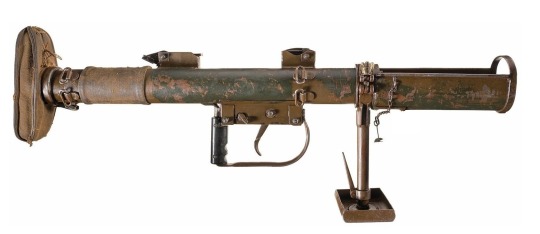
The PIAT at Ismailia
This still from a British Pathe newsreel about the battle for the Ismailia Governorate building and Egyptian Police barracks (Bureau Sanitaire) in January 1952, during an escalation of the tensions due to the British occupation of the Suez Canal Zone. This footage represents one of the last operational uses of the Projector, Infantry, Anti-Tank (PIAT). At the time it was beginning to be replaced by the US M20 3.5in ‘Super Bazooka’.
The British Army had garrisoned the Suez Canal Zone since the end of the Second World War and were subject to regular low level attacks. With increasing pressure from the Egyptian government to withdraw from the zone tensions rose further when the 1936 Anglo-Egyptian defence treaty was repealed. The British called on Egyptian police stationed in Ismailia, whom were allegedly responsible for some of the attacks on British troops, to surrender their weapons on 25th January 1952. The police refused and fighting around the police barracks broke out.
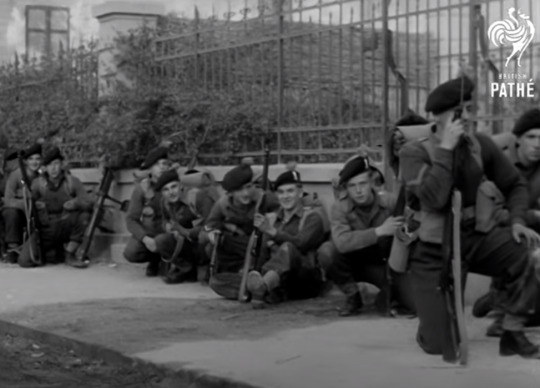
The rest of the platoon are armed with a mix of Rifle No.4s and Sten MkVs (source)
Men of the 1st battalion, Lancashire Fusiliers, along with elements of the 4th battalion, Royal Tank Regiment, surrounded the police barracks - with 800 police inside. In the still above men of the Lancashire Fusiliers await orders. There leaning against the wall is a platoon’s PIAT. It’s unclear if the PIAT was used during the fighting around the barracks, one of the weapon’s secondary roles was ‘house breaking’ essentially breaching holes in walls, but with armoured cars and Centurion tanks of the Royal Tank Regiment it is unclear if it would have been needed.
The barracks were bombarded and attacked by the Lancashire Fusiliers suffering three killed and 13 casualties during an assault. Following another bombardment the Egyptian police suffered 41 killed, 73 wounded, and a further 886 surrendered. In 1955 the British army began pulling out of the Canal Zone but would soon return. The PIAT was officially declared obsolete in the summer of 1956, just as the Suez Crisis loomed.
Sources:
Ismailia; Army Seize Police H.Q. (1952), British Pathe, (source)
Suez Canal Zone, National Army Museum, (source)
Egypt (British Military Action, Ismailia), 31 January 1952 vol 495, UK Hansard, (source)
If you enjoy the content please consider supporting Historical Firearms through Patreon!
#History#Military History#PIAT#Ismailia#Cold War#Post Colonialism#Projector Infantry Anti Tank#Guns#gunblr
34 notes
·
View notes
Text

• Boys Anti-Tank Rifle
The Rifle, Anti-Tank, .55in, Boys, commonly known as the "Boys Anti-tank Rifle", was a British anti-tank rifle in use during the Second World War. It was often nicknamed the "elephant gun" by its users due to its size and large bore. Although adequate against light tanks and tankettes in the early part of the war, the Boys was ineffective against heavier armour and was phased out in favour of the hollow charge-based PIAT mid-war.
There were three main versions of the Boys: an early model (Mark I) which had a circular muzzle brake and T-shaped monopod, built primarily at BSA in England; a later model (Mk I*) built primarily at the John Inglis and Company in Toronto, Ontario, Canada, that had a square muzzle brake and a V shaped bipod; and a third model made for airborne forces with a 30-inch (762 mm) barrel and no muzzle brake. There were also different cartridges, with a later version offering better penetration. The eponymous creator of this firearm was Captain Henry C. Boys, who was a member of the British Small Arms Committee and a designer at the Royal Small Arms Factory, Enfield.
It was initially called Stanchion but was renamed after Captain Boys as a mark of respect when he died a few days before the rifle was approved for service in November 1937. A bolt action rifle fed from a five-shot magazine, the weapon was large and heavy with a bipod at the front and a separate grip below the padded butt. In order to combat the recoil caused by the large 0.55 inch (13.9 mm) round, a muzzle brake was fitted on the barrel while the receiver was allowed to slide along the frame with a shock absorber attached to the rear of the rifle. Despite its recoil slide and rubber-cushioned buttpad, the recoil of the weapon (along with noise and muzzle blast) was said to be painful, frequently causing neck strains and bruised shoulders. Consequently, the Boys was almost never fired as a free weapon (that is, not affixed to a support) except in emergencies.
The Boys rifle was used in the early stages of the Second World War against lightly armoured German tanks and combat vehicles. Britain also supplied a large number of Boys anti-tank rifles to Finland in 1939 and 1940 during the Winter War with the Soviet Union. The weapon was popular with the Finns because it could deal with Soviet T-26 tanks, which the Finnish Army encountered in many engagements. Although useful against early German and Italian tanks in France and North Africa, as well as in the Norwegian campaign, such as the Panzer I, Panzer II and early models of Panzer III, increases in vehicle armour during the Second World War left the Boys largely ineffectual as an anti-tank weapon. A shortened version was deployed in 1942 for issue to airborne forces and saw use in Tunisia, where it proved completely ineffective because of the reduced velocity caused by the shortened barrel.
The Boys' reputation after the Battle of France was such that the Canadian government, through the Directorate of Military Training, The Department of National Defence and National Film Board of Canada (NFB) commissioned a training film, Stop That Tank! (1942), from Walt Disney Studios to counter the rifle's "jinx" reputation. Nonetheless, in the European theatre, it was soon replaced by the PIAT (Projector, Infantry, Anti-Tank) in 1943, which first saw service during the Allied invasion of Sicily. In other roles, the Boys saw some use against bunkers, machine gun nests and light-skinned vehicles but was rapidly replaced in British and Commonwealth service.
The weapon was standard issue to British and Commonwealth forces which attempted to stem the Japanese onslaught through the Pacific theatre. The U.S. Marine Corps purchased Canadian Boys rifles prior to the attack on Pearl Harbor. They saw limited use by the Marine Raider Battalions against enemy bunkers and aided in shooting down two seaplanes off Makin Island. The Boys rifles were also used by the Chinese Nationalist Army during the late Second Sino-Japanese War in both China and Burma. The Boys rifle was also equipped and used by the Philippine Army and Philippine Constabulary during the Second World War against the Japanese occupation and to aid the Allied liberation.
#second world war#world war 2#world war ii#military weapons#military history#firearms#military#history#british commonwealth#wwii
58 notes
·
View notes
Text
Chocobo Knights (Final Rose)
In an age of increasingly advanced technology and projectile weaponry, there are many who believe that the age of the chocobo knight might finally be over. They couldn’t be more wrong. As recent battles against both Grimm and other military forces have shown, chocobo knights remain a terrifying and effective force on the battlefield.
Most chocobo knights ride either gold or black-and-red chocobos. These chocobos typically stand between ten to eleven feet tall and weigh hundreds of pounds. They are also capable of maintaining speeds in excess of two hundred miles per hour for extended lengths of time and can even go supersonic for short bursts.
In terms of equipment, modern chocobo knights take full advantage of the most advanced armour and shielding technology. The immense strength of chocobos allows them to carry multiple Aura batteries and shield projectors, which vastly increase their durability and enables them to basically ignore small arms fire and even artillery. As for the riders, they are heavily armoured and shielded, and they carry a combination of firearms and melee weapons.
What makes chocobo knights so devastating even in the modern age is the strength of their charge. The sheer amount of damage that hundreds of pounds of chocobo and knight can do when travelling at two hundred miles per hour is incredible. However, chocobos of the calibre ridden by chocobo knights typically possess the ability to massively increase their speed for short durations of time.
This ability has led to chocobos being clocked at more than eight hundred miles per hour for periods as long as ten seconds. Combined with their enormous durability and heavy armour and shielding, this essentially turns each chocobo into a wrecking ball that will crush anything and everything in its path.
Perhaps the most devastating example of the damage chocobo knights can do occurred during the Great War. A force of some five thousand chocobo knights from the Mi’ihen Clan encountered a Mantle army comprised of one hundred thousand troops.
The Mantle forces immediately assumed a defensive posture and bombarded the chocobo knights with artillery, small arms fire, and heavy machine gun fire. Forming the best line the could, the Mi’ihen forces charged. More than one thousand chocobo knights fell before they could reach the Mantle lines.
By the end of the day, however, more than seventy-five thousand Mantle soldiers were dead with the rest in full retreat. Despite losing a fifth of their numbers before reaching the enemy, the remaining chocobo knights struck the Mantle position at full speed.
The Mantle front lines evaporated in the face of the charge. Travelling at full speed, the chocobo knights did not even have to use their weaponry to kill their opponents. A chocobo travelling at several hundred miles an hour will reduce anyone it hits to a bloody pulp.
As Mantle’s front lines disintegrated, the chocobo knights spread using rapid-fire grenade launchers to wreak absolute havoc across the battlefield before switching to melee weapons as they wheeled around for a second strike. By targeting heavy weaponry first, the chocobo knights ensured that the remainder of their foes were standard infantry, and a standard infantryman has about as much chance of killing a chocobo knight with full shielding and armour as they do of killing an ancient Grimm.
In practice, the only real way to deal with chocobo knights is the use of heavy fortifications and ample quantities of ranged weapons - or to use your own chocobo knights. In this regard, the Yun and Dia Clans have demonstrated the efficacy of powerful ranged weaponry in conjunction with a counter charge.
Chocobo knights have also proven to be exceptionally effective against hordes of lesser Grimm since they too can be run down and simply trampled. However, they have proven to be less successful against colossal Grimm that are actually capable of withstanding the weight of their charge. Against such titanic creatures, chocobo knights have been known to sustain horrifying casualties although improvements in weapons technology have increased their effectiveness somewhat.
In the modern age, the standard practice is to deploy chocobo knights in conjunction with other conventional troops. Using armour and infantry support to saturate oncoming Grimm with projectile fire leaves them easy prey for the chocobo knights who should have no problems smashing their way through a scattered, battered formation of Grimm. Chocobo knights have also seen extensive use as a rapid response force due to their speed and ability to strike hard and then retreat before further retaliation arrives. This has made them key to dealing with Grimm swarms and hordes that attack across large areas of territory.
At present, almost all chocobo knights are from the Clans although the various kingdoms and factions have been trying to train their own. The largest single group come from the Mi’ihen clan that can field some thirty thousand chocobo knights at full strength. The second largest group come from the Yun who can field fifteen thousand although all of the clans are able to field at least five thousand each except for the Dia who rely almost entirely on the Yun in that regard.
Keep in mind that almost all of the Mi’ihen clan’s military is made up of chocobo knights. In contrast, the other clans maintain more balanced forces. On the opposite side of the scale are the Dia who have almost entirely eschewed chocobo knights in favour of advanced armour (e.g., tanks, mechs, etc.) and advanced aerial units (e.g., sky ships, drones, etc.) to fill that same role.
If you’re interested in my thoughts on writing and other topics, you can find those here.
You can find my original fiction on Amazon here.
8 notes
·
View notes
Text
Spartan Assault Tank
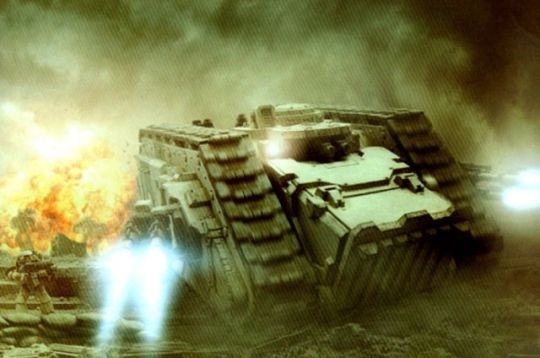
The Spartan Assault Tank, sometimes referred to as the Land Raider Spartan, is a heavy-assault transport that was originally used by the Space Marine Legions during the Great Crusade and Horus Heresy, and later by the Chapters of the Adeptus Astartes that still possess them in their armoury. The Spartan is a massive vehicle, and is one of the largest ground vehicles ever used by the Space Marines, smaller only than their ancient super-heavy vehicles such as the Mastodon, Fellblade, and Falchion. The Spartan also has the largest carrying capacity of all non-super-heavy vehicles, with the ability to carry 25 Power Armoured Space Marines or 12 Astartes in Terminator Armour. The Spartan is an extremely durable and completely sealed assault transport armed with heavy weapons and possessed of a high transport capacity, but the true genius of the Spartan is that the greater proportion of its interior space is given over to carrying capacity, and yet the vehicle's engine and drive system still allows it to travel at speeds much higher than that of similar-sized transports, such as the Gorgon used by the Imperial Army and the Astartes' own Mastodon. The Spartan Assault Tank was used by most, if not all of the Space Marine Legions during the Great Crusade and the Horus Heresy, and after the Legions were broken down into Chapters during the Second Founding many of the newly-formed Space Marine units retained several of these vehicles in their armouries. It is unknown if the Adeptus Mechanicus is able to build new Spartan Assault Tanks in the late 41st Millennium or if the technology has been lost like so much else from the Great Crusade era.
History
The Spartan Assault Tank was designed by the Mechanicum of Mars for the Space Marine Legions as a way to carry their Terminators into combat. This was because the Land Raider Proteus, the only Land Raider the Space Marine Legions had access to early in the Great Crusade, was unable to carry the bulk of Terminators and a way to carry these highly-effective warriors quickly into combat was needed. One tale says that the Spartan was designed specifically so that an Astartes strike force could cross a region ablaze with raging plasma fires, referred to as the Ring of Death. The Space Marines amassed their Terminators and used the first Spartans to carry them across this region, losing all but a fraction of the Terminator Squads. The sacrifice proved not in vain though as the battle was eventually won, and a new war machine was born in its aftermath.
Armament
The Spartan Assault Tank is heavily-armed with powerful weaponry, and is more than capable of defending itself from an attack. The Spartan is a powerful war machine in its own right, as it is fully capable of destroying entire squads of enemy infantry or tanks with its heavy weapons. The Spartan is armed with two sponson-mounted Quad-Lascannons, one on each side of the tank, and a single, hull-mounted, forward-firing twin-linked Heavy Bolter. The tank's Quad-Lascannons are able to make quick work of most armoured vehicles, and its twin-linked Heavy Bolters are used to provide covering fire for disembarking troops. The Spartan can replace its Quad-Lascannons for Laser Destroyer Arrays, which are useful against both enemy heavy armour and infantry. The Spartan is also always equipped with both a searchlight and smoke launchers, but can also be equipped with a Hunter-Killer Missile Launcher, an auxiliary drive system that can be used if the vehicle's main drive system is damaged or destroyed, a Flare Shield, an extra layer of armoured ceramite for increased protection at the cost of speed, and a dozer blade for clearing debris and mines. The tank can also be outfitted with a Pintle-mounted weapon, such as a Storm Bolter, a Heavy Flamer, or a Multi-Melta. During the Great Crusade and Horus Heresy, the Spartan Assault Tank could have been armed with other weapons such as a Combi-Bolter, another Combi-weapon, or a Havoc Missile Launcher. The Spartan can also have Frag Assault Launchers attached to its front, on either side of the front debarkation ramp, to blast the targeted area with shrapnel before its cargo of troops disembark. Like all Land Raiders and their variants, the Spartan Assault Tank is equipped with a powerful Machine Spirit, which is capable of taking control of the vehicle and its weapons if the crew is killed or otherwise unable to operate the vehicle.
Variants
Typhon Heavy Siege Tank - The Typhon Heavy Siege Tank is a variant of the Spartan Assault Tank that was designed to be used during sieges and is equipped with a powerful siege weapon known as the Dreadhammer Siege Cannon. The Typhon was developed by the Mechanicum during the Great Crusade in response to a request by the Primarch of the Iron Warriors Legion, Perturabo, for an Astartes vehicle that could quickly deploy heavy, fortress-breaking firepower to the front lines, so that no time would be lost waiting for the Imperial Army's slow artillery batteries.
Cerberus Heavy Tank Destroyer - The Cerberus Heavy Tank Destroyer was a rare experimental variant of the Spartan Assault Tank. The Cerberus was designed by the Mechanicum to use the massive internal space of the Spartan's chassis to mount a Neutron Laser Projector, a more powerful and unstable variant of the Neutron Laser Cannon that would later be used by the Astartes' Sabre Tank Hunters and the Valdor Tank Hunters of the Imperial Army. It is believed that the Neutron Laser Battery was scaled down to create the smaller, and more stable, Neutron Laser Cannon. As the Cerberus was used to field-test the first Neutron-based weaponry, they were not as widely mass-produced as the other Spartan variants.
Land Raider Phobos - Although the Land Raider Phobos does not use the Spartan's chassis, many of the design features of the Spartan, and the older Land Raider Proteus, would be incorporated into the the first Land Raider that could transport Terminators. Sometime during the latter half of the Great Crusade the Mechanicum developed the Land Raider Phobos as the primary replacement for the Land Raider Proteus. The Land Raider Phobos takes the best of both the Land Raider Proteus and the Spartan Assault Tank's designs. As a testament to the robust nature of this design, the Land Raider Phobos is still used by every single Space Marine Chapter after nearly 10,000 standard years, and has even spawned many common variants of its own.
Chaos Spartan Assault Tank - The Spartan Assault Tank was used on both sides of the Horus Heresy, and after the death of Horus at the hands of the Emperor the surviving Traitor Primarchs and their Legions fled Imperial space, most to the Eye of Terror. These Legions took their Spartan Assault Tanks with them, where they would be corrupted and twisted by the malign powers of the Warp. Spartan Assault Tanks used by the Traitor Legions are armed with weaponry no longer used by the Imperium, such as Reaper Autocannons, Havoc Missile Launchers, and Pintle-mounted Combi-Weapons. The vehicle's crew may even be permanently fused to the vehicle itself, or the tank may be controlled by Daemons.
Known Users of the Spartan Assault Tank
The following are the known users of the Spartan Assault Tank:
Space Marine Legions - The Spartan Assault Tank was used by most, if not all, of the original Space Marine Legions during the Great Crusade and the Horus Heresy. Some Legions, such as the Death Guard and the Sons of Horus, made especially extensive use of the Spartan tank.
Second Founding Chapters - When the Space Marine Legions were broken up into 1,000 man Chapters during the Second Founding any Spartan Assault Tanks that survived the Horus Heresy and the Great Scouring were divided up and given to these newly formed Chapters. It is unknown if the present day Adeptus Mechanicus is able to build new Spartans or if the technology has been lost.
Chaos Space Marine Legions - After the death of Horus Lupercal at the end of the Horus Heresy, the nine Traitor Legions either fled to the Eye of Terror or into uncharted space, taking any surviving Spartans with them. Chaos Spartan Assault Tanks are corrupted and twisted by their exposure to the Warp, yet this has not negatively affected the vehicle's performance or capacity for destruction in any way.
Source: http://warhammer40k.wikia.com
#horus heresy#warhammer 40k#adeptus sororitas#adeptus arbites#adeptus astartes#adeptus custodes#adeptus mechanicus#astra militarum#Adeptus Astra Telepathica#officio assassinorum
22 notes
·
View notes
Photo
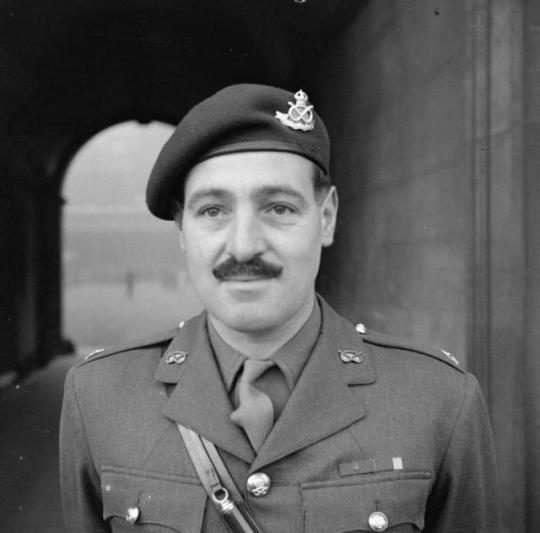
How Major Robert Cain won the Victoria Cross during Operation Market Garden
Perhaps the most famous actions involving the Projector, Infantry, Anti-Tank (PIAT) during Operation Market Garden are those carried out by Major Robert Cain, of 2nd Bn South Staffordshire Regt. Cain and his men had been blocked from reaching Lt.Col. John Frost’s PARA’s at the bridge in Arnhem and had formed a defensive perimeter in nearby Oosterbeek.
Throughout the battle the British Airborne forces relied heavily on the PIAT and Major Cain put the weapon to good use. At one point during the battle he used a PIAT, in its secondary in-direct mortar role, in an attempt to drop bombs onto a self-propelled gun which was positioned on the other side of a house. Sadly, Cain wasn’t able to destroy the SPG before his spotter, Lieutenant Meikle, was killed by enemy fire and he was wounded by falling masonry.

Projector, Infantry, Anti-Tank - PIAT (source)
On the 21st September he engaged and destroyed an enemy tank with the PIAT. He then moved to take on a second tank but as he fired the bomb prematurely detonated just as it left the weapon - likely due to a faulty fuse or a misaligned bomb. Cain was wounded again being thrown back by the blast and being hit by metal fragments.
Throughout the fighting Cain displayed massive courage engaging German armoured vehicles at close ranges with the PIAT personally destroying or helping to destroy half a dozen vehicles. By the 25th Sept Cain & his men had run out of ammo for their PIATs and he himself began using a 2in mortar, fired at high angle, to try and hold the enemy off.
For his gallantry during the battle he was awarded the Victoria Cross, he was the only Arnhem VC recipient to survive the battle.
Here’s Cain’s VC citation in full:
“In Holland on 19th September, 1944, Major Cain was commanding a rifle company of the South Staffordshire Regiment during the Battle of Arnhem when his company was cut off from the rest of the battalion and during the next six days was closely engaged with enemy tanks, self-propelled guns and infantry. The Germans made repeated attempts to break into the company position by infiltration and had they succeeded in doing so the whole situation of the Airborne Troops would have been jeopardised.
Major Cain, by his outstanding devotion to duty and remarkable powers of leadership, was to a large extent personally responsible for saving a vital sector from falling into the hands of the enemy.
On 20th September a Tiger tank approached the area held by his company and Major Cain went out alone to deal with it armed with a Piat. Taking up a position he held his fire until the tank was only 20 yards away when he opened up. The tank immediately halted and turned its guns on him, shooting away a corner of the house near where this officer was lying. Although wounded by machine gun bullets and falling masonry, Major Cain continued firing until he had scored several direct hits, immobilised the tank and supervised the bringing up of a 75 mm. howitzer which completely destroyed it. Only then would he consent to have his wounds dressed.
In the next morning this officer drove off three more tanks by the fearless use of his Piat, on each occasion leaving cover and taking up position in open ground with complete disregard for his personal safety.
During the following days, Major Cain was everywhere where danger threatened, moving amongst his men and encouraging them by his fearless example to hold out. He refused rest and medical attention in spite of the fact that his hearing had been seriously impaired because of a perforated eardrum and he was suffering from multiple wounds.
On 25 September the enemy made a concerted attack on Major Cain's position, using self-propelled guns, flame throwers and infantry. By this time the last Piat had been put out of action and Major Cain was armed with only a light 2" mortar. However, by a skilful use of this weapon and his daring leadership of the few men still under his command, he completely demoralised the enemy who, after an engagement lasting more than three hours, withdrew in disorder.
Throughout the whole course of the Battle of Arnhem, Major Cain showed superb gallantry. His powers of endurance and leadership were the admiration of all his fellow officers and stories of his valour were being constantly exchanged amongst the troops. His coolness and courage under incessant fire could not be surpassed.”
You can read about more Victoria Cross actions and recipients here.
Sources:
Image
The London Gazette, 31 October 1944 (source)
If you enjoy the content please consider supporting Historical Firearms through Patreon!
#History#Military History#Market Garden#Major Robert Cain#Battle of Arnhem#Victoria Cross#WW2#WWII#World War Two#Market Garden75#Arnhem 75#75th Anniversary of Market Garden#A Bridge Too Far#Oosterbeek#PIAT#Projector Infantry Anti-Tank#South Staffordshire Regiment#Airborne forces#Airborne
96 notes
·
View notes
Photo

August 2018 - HF Patreon Wallpaper - PIAT
This month's HF Wallpaper takes a look at the Projector, Infantry, Anti-Tank or PIAT. Developed by the British in 1941-42 as an anti-tank weapon capable of taking on Germany's most armoured tanks.
Powered by a powerful spring, the PIAT uses a spigot mortar to project a high explosive shape charge. Initially designed by Stewart Blacker, best known for his Blacker Bombard, a larger 29mm Spigot Mortar, it was further refined by Major Millis Jefferis of Britain's special weapons development department, MD1.
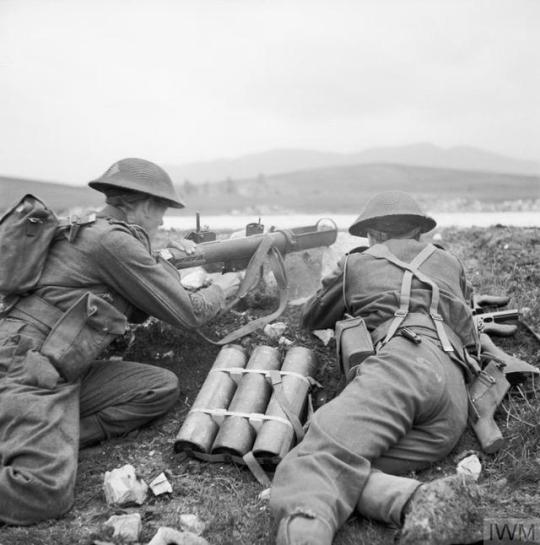
Preceding the American Bazooka, the PIAT first saw action in Sicily in the summer of 1943. It went on to be used by all of the British Commonwealth forces including Australia - who referred to it as the PITA or Projector, Infantry, Tank Attack. It was also dropped to resistance fighters in occupied Europe including in France and Poland.
With a somewhat limited range of 100m, and often used much closer, no less than 7 Victoria Crosses were won using PIATs. In this month's wallpaper we see the drawings from Jefferis' original 1942 patent, which was only granted after the war - due to secrecy.
If you'd like to know more about the PIAT you can check out my earlier article about it here.
Thank you as always for your continued support, if you’d like to support HF via Patreon and download this month’s wallpaper (and all the others I’ve made) you can check out Patreon here!
~Matt
#History#PIAT#Historical Firearms Wallpaper#Weapons#WW2#WWII#World War Two#Small Arms#Anti-tank weapons#HF Patreon Wallpaper#Patreon#Support#Thank you!#military history
42 notes
·
View notes
Photo
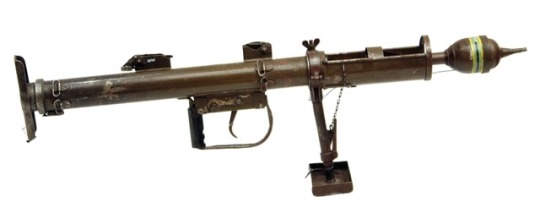

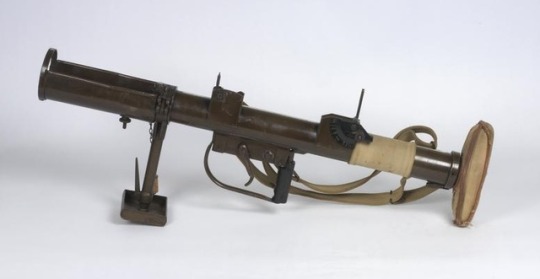

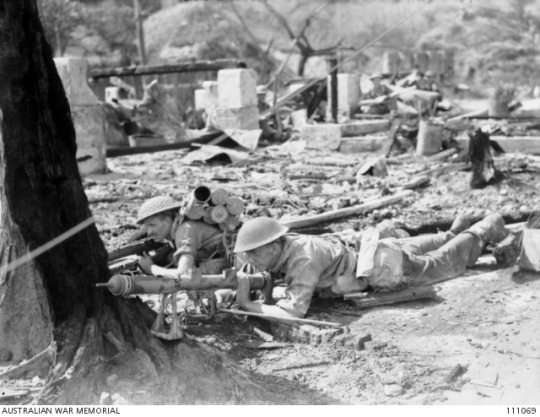
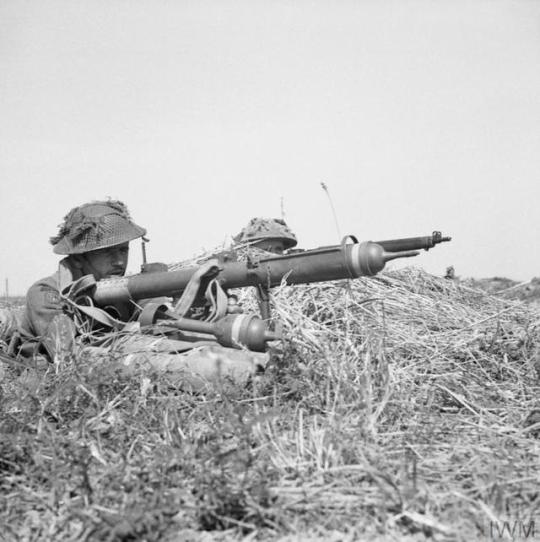
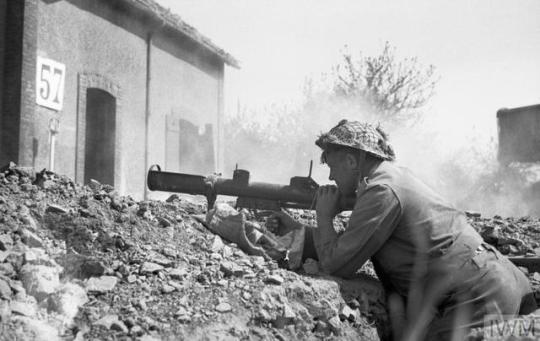
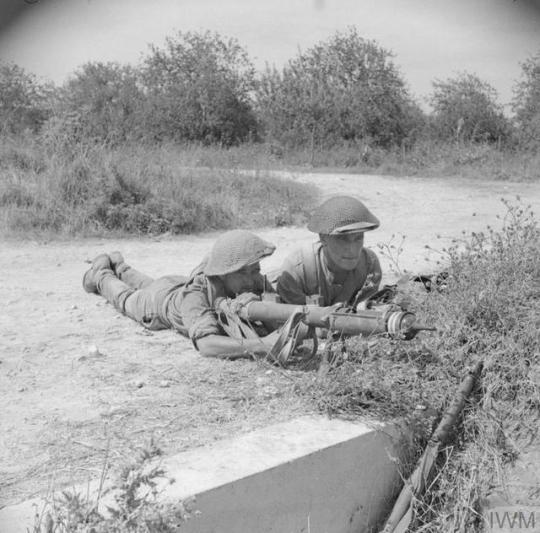
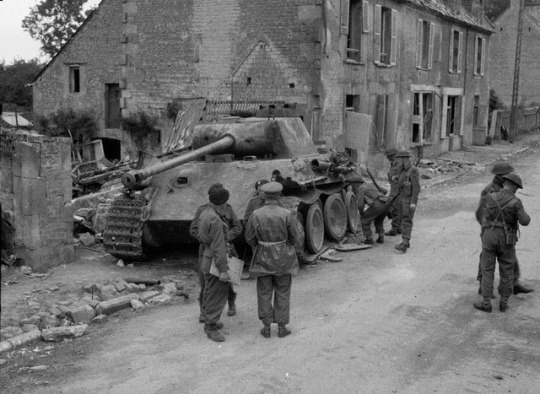
The Projector, Infantry, Anti Tank (PIAT)
In 1941, Britain began developing the Projector, Infantry, Anti Tank, better known as the PIAT. The PIAT would become Britain’s primary anti-tank weapon during World War Two. A year earlier in 1940, the British developed the No. 68 AT Rifle Grenade, however, the No.68 proved unsuccessful and was not widely used. The .55 calibre Boys AT rifle had been in service since 1937, but was quickly found to be ineffective against thicker German armour. The PIAT was a response to the infantry soldier’s need for a lightweight, ranged anti-tank weapon.
Lt-Col. Stewart Blacker took his the 29mm Spigot Mortar, known as the Blacker Bombard, as a basis for a smaller, more portable spigot-based weapon. Blacker developed what he called the ‘Baby Bombard’ - a man-portable, shoulder fired weapon using a hollow charge bomb with a propellant charge in the tail. The Baby Bombard had a large spring and spigot at the base - when the weapon fired the spring was released and the spigot projected up the tail tube of the bomb projecting igniting the propellant charge inside. The ignited propellant charge then forced the bomb off the spigot with propellant gases expanding between the bomb and the spigot throwing it down range. The Baby Bombard was shown to the War Office in June 1941, but initial testing was disappointing. While Blacker moved on to other duties, continuing development was overseen by Major Millis Jefferis, an explosives expert and skilled engineer, at the Ministry of Defence’s research and development establishment MD1. Jefferis redesigned the Baby Bombard, rechristening it the 'Jefferis Shoulder Gun’. It was adopted in the summer of 1942, following successful testing by the Ordnance Board.
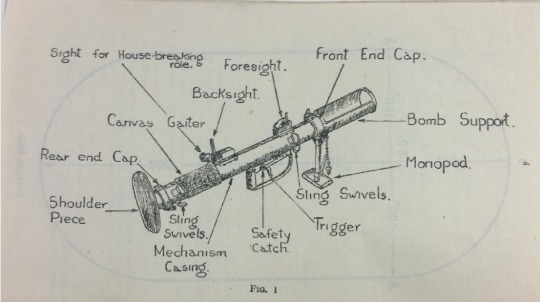
Diagram showing the parts of the PIAT from a 1943 training manual (source)
PIAT production began in August 1942, and it first saw action in the summer of 1943, during the Allied invasion of Sicily and remained in service into the 1950s. Imperial Chemical Industries Ltd. and other manufacturers produced approximately 115,000 by the end of the war.
The weapon itself was 39 inches (1m) long and weighed 32 lbs (15kg). The PIAT was not a rocket launcher, instead it relied on a spring-loaded spigot to detonate a propellant charge and launch a bomb containing a shaped charge.Unlike a rocket launcher the PIAT did not have to withstand high pressures and could be made from sheet steel. the positives of the system included its lack of muzzle flash and relatively little report unlike American Bazookas and German Panzerfausts. It was also relatively cheap to manufacture. However, its main drawbacks were its heavy recoil, problems cocking the weapon and the fragile sheet steel it was made from.
The performance of the PIAT in terms of range and armour penetration was adequate. The 3lb (1.35kg) projectile when fired within 100m could penetrate in excess of 100mm of armour. Optimally the projectile could achieve a muzzle velocity of approximately 450ft/s (137m/s). Although as armour skirts came into use the PIAT became less effective. Its maximum effective range against armour was 115 yards (110m), the PIAT could be used against fixed positions and buildings at up to 350 yards (320m) by arcing projectiles onto the target. It was aimed using an aperture sight and could be stabilised with the weapon’s monopod.
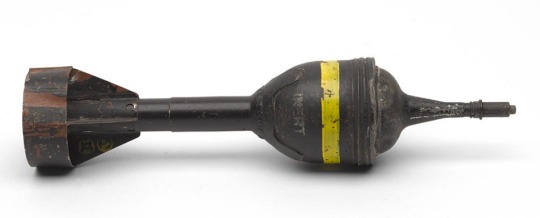
An inert 3lb high explosive PIAT bomb (source)
Each platoon was issued one PIAT, it could be operated by one man but was normally deployed by a two man team, with the second man acting as ammunition carrier and loader. They were extremely useful for airborne units, offering a support weapon able to answer both enemy armour and fixed positions. They were used throughout the war being issued to infantry and also mounted on Universal (Bren Gun) Carriers with mechanised units.
Britain, Canada, Australia and the other Commonwealth nations all used the PIAT. In Australian service it was designated the 'Projector Infantry Tank Attack’ or PITA. The British also dropped PIATs to resistance fighters operating in occupied Europe with many used by the French resistance and some seeing action during the Warsaw Uprising.
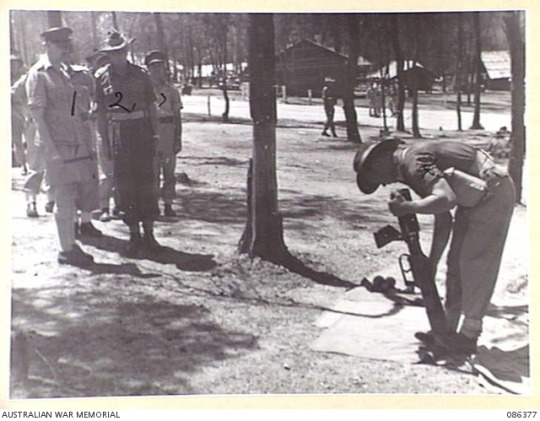
Australian Infantryman demonstrates the loading of a PIAT to Maj. General Milford, c.1945 (source)
Due to their limited range, of about 100 yards, PIATs took a certain amount of courage to use in action. As a result six men were awarded the Victoria Cross for using them to destroy German tanks. During the battle for Arnhem, during Operation Market Garden Major Robert Cain, of 2nd South Staffordshire Regt., won a VC single-handedly immobilising a German Stug Assault Gun and forced three Panzer IVs to retreat using a PIAT. Similarly in Italy in October 1944, Private Ernest Smith used a PIAT to destroy a German Mark V Panther tank winning a VC. 7% of all tanks destroyed by British forces during D-Day operations were knocked out by PIATs, more than destroyed by rocket armed aircraft. Image #7 shows a German Panther tank that was allegedly knocked-out by a PIAT in Bretteville-en-Orguilleuse, near Caen, in summer 1944.
The PIAT needed to be manually cocked before the first shot, theoretically the recoil from firing would then re-cock it for subsequent shots. Cocking was achieved by compressing a large spring within the body of the launcher, this was difficult to achieve without standing up. The PIAT’s manual does depict and explain how this could be accomplished in the prone position.
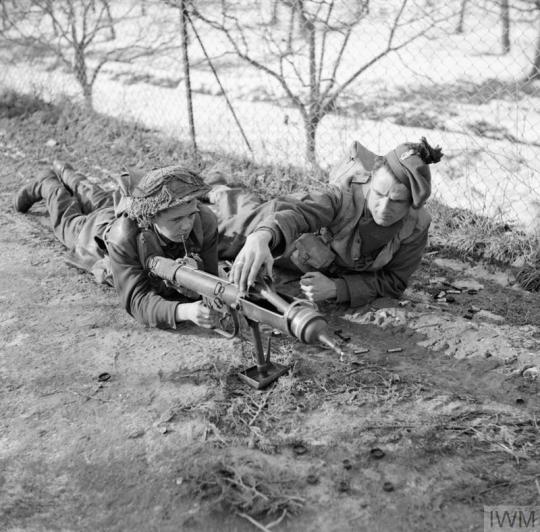
PIAT team from the 1st Btn. London Irish Rifles, the number two loads a projectile (source)
To ready the PIAT to fire the operator would stand the PIAT on its butt, holding it firmly twist the weapon to disconnect the shoulder pad which was attached to the cocking rod. By standing on the shoulder pad and pulling the body of the weapon up the spigot (which acted as a firing pin) and spring were compressed and the spring into the firing position and attached it to the trigger mechanism cocking the weapon. The body was then slid back down to the shoulder pad and re-latched. A projectile was then placed in the in the trough/tray at the front of the weapon. The 'draw weight’ of the PIAT equalled ~90kg of spring tension. The PIAT was difficult to operate by smaller, shorter soldiers. The recoil caused by the detonation of the propellant then blew the spigot/iring pin backwards onto the spring; this automatically cocked the weapon for subsequent shots, theoretically eliminating the need to manually re-cock
While the PIAT was heavy, cumbersome, difficult to cock and hard on the shoulder when fired. It proved an effective anti-tank weapon, capable of defeating most tanks when used with cunning and daring. They later saw action during the Korean War but were phased out of service by the mid-1950s. But were soon replaced by US M20 'Bazooka’ rocket launchers and the No.94 ENERGA AT-Rifle Grenade. The Haganah, the predecessor of the IDF, also used British PIATs during the 1948 Israeli War of Independence.
Sources:
Images: 1 2 3 4 5 6 7 8 9
Projector, Infantry, Anti-Tank, IWM, (source)
PIAT, ParaData, (source)

If you enjoy the content please consider supporting Historical Firearms through Patreon!
#History#Military History#PIAT#Anti tank weapon#Projector Infantry Anti Tank#Ordnance of the Week#British Army#World War Two#Korean War#Spigot Mortar#Blacker Bombard#Baby Bombard#Stewart Blacker#Millis Jefferis#MD1#WWII#WW2#Weapons#Firearms#AT weapons#PITA#Projector Infantry Tank Attack#Bazooka#gunblr#anti tank weapons#anti tank launcher
288 notes
·
View notes